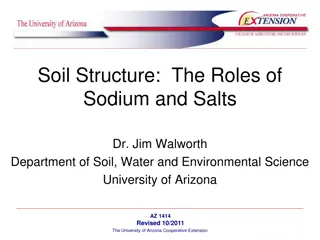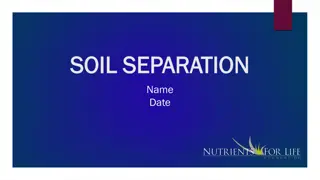Understanding Excess Soil Water and Plant Growth in Water Management
Excess soil water can lead to waterlogging, affecting plant growth negatively by creating anaerobic conditions, promoting growth of water-loving plants, hindering tillage operations, accumulating harmful salts, lowering soil temperature, and reducing crop maturity time. Preventive measures include controlling water seepage from canals. Proper drainage is crucial to avoid waterlogging and maintain soil health for optimal crop growth.
Uploaded on Sep 13, 2024 | 0 Views
Download Presentation

Please find below an Image/Link to download the presentation.
The content on the website is provided AS IS for your information and personal use only. It may not be sold, licensed, or shared on other websites without obtaining consent from the author. Download presentation by click this link. If you encounter any issues during the download, it is possible that the publisher has removed the file from their server.
E N D
Presentation Transcript
Course name Principles and Practices of Water Management (AGRO 0504) Course Credit 2+1 Lecture 14 Topic: Excess of soil water and plant growth
UNIT V Excess of soil water and plant growth When the conditions are so created that the crop root-zone gets deprived of proper aeration due to the presence of excessive moisture or water content, the tract is said to be waterlogged. To create such conditions it is not always necessary that under groundwater table should enter the crop root-zone. Sometimes even if water table is below the root-zone depth the capillary water zone may extend in the root-zone depth and makes the air circulation impossible by filling the pores in the soil.
Causes of Waterlogging i. Inadequate drainage of over-land run-off increases the rate of percolation and in turn helps in raising the water table. ii. The water from rivers may infiltrate into the soil. iii. Seepage of water from earthen canals also adds significant quantity of water to the underground reservoir continuously. iv. Sometimes subsoil does not permit free flow of subsoil water which may accentuate the process of raising the water table. v. Irrigation water is used to flood the fields. If it is used in excess it may help appreciably in raising the water table. Good drainage facility is very essential.
Effects of Waterlogging The waterlogging affects the land in various ways. The various after effects are the following: 1. Creation of Anaerobic Condition in the Crop Root-Zone: When the aeration of the soil is satisfactory bacteriological activities produce the required nitrates from the nitrogenous compounds present in the soil. It helps the crop growth. Excessive moisture content creates anaerobic condition in the soil. The plant roots do not get the required nourishing food or nutrients. As a result crop growth is badly affected. 2. Growth of Water Loving Wild Plants: When the soil is waterlogged water loving wild plant life grows abundantly. The growth of wild plants totally prevent the growth of useful crops. 3. Impossibility of Tillage Operations: Waterlogged fields cannot be tilled properly. The reason is that the soil contains excessive moisture content and it does not give proper tilth. 4. Accumulation of Harmful Salts: The upward water movement brings the toxic salts in the crop root-zone. Excess accumulation of these salts may turn the soil alkaline. It may hamper the crop growth. 5. Lowering of Soil Temperature: The presence of excessive moisture content lowers the temperature of the soil. In low temperature the bacteriological activities are retarded which affects the crop growth badly. 6. Reduction in Time of Maturity: Untimely maturity of the crops is the characteristic of waterlogged lands. Due to this shortening of crop period the crop yield is reduced considerably.
Preventive Measures (a) Controlling the loss of water due to seepage from the canals: The seepage loss may be reduced by adopting various measures for example i. By lowering the FSL of the canal: Loss may be due to percolation or absorption but when FSL is lowered the loss is reduced to sufficient extent. It is course essential to see that while lowering the FSL command is not sacrificed. ii. By lining the canal section: When the canal section is made fairly watertight by providing lining the seepage loss is reduced to quite a good extent. iii. By introducing intercepting drains: They are generally constructed parallel to the canal. They give exceptionally good results for the reach where the canal runs in high embankments. (b) Preventing the loss of water due to percolation from field channels and fields: The percolation loss can be removed by using water more economically. It may also be affected by keeping intensity of irrigation low. Then only small portion of the irrigable tract is flooded and consequently the percolation loss takes place only on the limited area. It keeps the water-table sufficiently low.
(c) Augmentation of outflow and prevention of inflow: It may be accomplished by introducing artificial open and underground drainage grid. It may also be achieved by improving the flow conditions of existing natural drainages. (d) Quick disposal of rainwater: Quick removal of rainwater by surface or open drains is a very effective method of preventing the rise in water table and consequent waterlogging of the tract. It is needless to state that the rainwater removed is net reduction in inflow.
Curative Measures: (a) Installation of lift irrigation systems: When a lift irrigation project in the form of a tube well irrigation system is introduced in the waterlogged area the water table gets lowered sufficiently. It is found to be very successful method of reclaiming waterlogged land. Thus a combination of a canal system and a supplementary tube well irrigation system may be considered to be most successful and efficient irrigation scheme. Of course it is true that it will create some complications while assessing the charges for irrigation water. (The canal water being cheaper than tube well water). Implementation of drainage schemes: The waterlogged area may be reclaimed by introducing overland and underground drainage schemes. (b) Implementation od Drainage Schemes: The waterlogged area may be reclaimed by introducing overland and underground drainage schemes.























